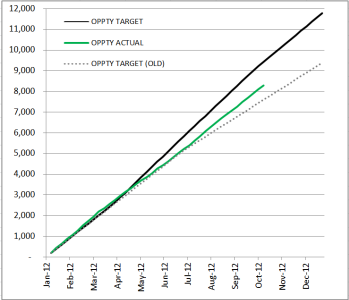The Zen Of PPC Campaign Reporting
Okay. It’s February. We’ve finally got all the year-end reporting and summaries for our clients done and delivered, and have set forth to meet our new plans and objectives for 2013 with big, fresh PPC budgets. And, except for the fact that it seems I am three months behind after only three weeks into the […]
Okay. It’s February. We’ve finally got all the year-end reporting and summaries for our clients done and delivered, and have set forth to meet our new plans and objectives for 2013 with big, fresh PPC budgets. And, except for the fact that it seems I am three months behind after only three weeks into the new year, I am still just as excited about the possibilities for PPC advertising this year as I was back in 2001 when I put up my first campaigns.
Having finished a detailed, three-part series on the Google Display Network last month, I thought I’d switch gears and jot down a few random aspirational musings about simplifying PPC reporting and finding better ways to preserve important historical findings inside our PPC campaigns.
These are my own chin-pulling musings — please feel free to add your own aspirations for the year ahead in the comments section at the end of this post.
The Zen Of Data Reporting
I have to admit to feeling a certain brotherhood with airline pilots who fly planes using a dizzying array of indicators, dials, levers, buttons and blinking lights that tell them everything about their planes operations so they can maintain proper course headings and schedules. Every reporting instrument and all the control levers and buttons within an arms length’s reach are important at some point in the flight.
The keys to a successful flight are the pilot’s ability to interpret real-time data from these complex data displays, to decide what changes are needed and the know-how to push the right buttons at the right times, gently or aggressively, to make appropriate course corrections.

Managing PPC and flying jumbo jets requires mastering complex data displays and controls. (iStockphoto used under license.)
I think that what we do as PPC campaign managers is very similar to that process.
All day long, we scan dashboards, real-time data charts and columns and rows of raw data, trying to get a handle on what’s happening inside our campaigns at that moment in time. And we feel a rush of adrenaline when we spot a particular trend or a sketchy data point out of range that jolts us into corrective action.
This sort of stimulation is what keeps us doing what we do. We love working with all the data. We love exerting control and changing performance quickly and forcefully. We pride ourselves on knowing exactly what buttons to push and when to push them (or not) in our Bing Ads and AdWords accounts.
However, as passionate as we may be about what we do, when it comes time to explain to our clients what we’ve accomplished, we can’t give them a running commentary on everything we’ve done and why we did it. A common tendency we all are guilty of at some point, is overwhelming our clients with data, numbers and charts. Maybe it is because we just can’t help gushing about what we do, or how clever we are, that we substitute voluminous data for actionable analysis and recommendations.
At the end of the day, though, the only thing our clients really want to know is “Are we on target?”
Here’s the problem. The process for, and the goals of, communicating results is nothing like the process of creating those results. Reporting results can and should be different and much more elegant.
For example, although a pilot might love to explain all the technical aspects of what they did in flying you from San Jose to Boston, they will probably simply say, “Welcome to Boston.” That really says it all.
So how can we ‘say it all’ about our PPC campaign efforts and achieve a similar simple reporting elegance? How can we eliminate every non-essential metric in our reporting, and by simplifying, make our reporting even more powerful? I don’t know the answer to that question, but one of my quests this year is to achieve the zen of client campaign reporting.
Visual displays of data, such as Excel charts and graphs are certainly going to be a part of that simplification process. Simple line charts like the one below are helpful, because they can show history, current status and provide a glimpse of what the future looks like with just three simple lines.
The chart below tells the story of what’s happening with an increase to ad spend budget implemented around May. The question on everyone’s mind is whether more ad budget will lead to more sales opportunities.

A simple trend line chart tells a complete story.
In this chart, the dotted line shows our original target goals based on the original budget. The black line shows the new targets expected from the increased budget. The green line shows the progress towards our new target. Our report to the client, based solely on this chart could be very simple. “We are making progress, but slow progress towards our new goals.”
But, we actually don’t even have to say a word. The client can see this for themselves because the gap between the green and black line is closing, but not very quickly. No more data is need to understand what is happening, it is self-evident in the chart.
Before we can achieve zen reporting, I think we must first establish clear, measurable goals and objectives for each of our campaigns. Without forward-looking objectives, we can only know where we are now and how we got here. That, unfortunately, is a story about the past and we can’t change the past, we can only describe it. We can only change what lies in front of us. With target goals and objectives, we are able to report where we started, where we are now, and most importantly, where we are heading.
Now, instead of worrying about what has already happened, we can quickly turn to discussions of what actions can be taken to change the trajectory of the future.
The Zen Of Change Management
Although we have been at the PPC game for more than a decade, we have yet to create the perfect ad group or campaign. Now I know it’s crazy to even consider perfection – as in an ad group where all the keywords all have 100% click-through and conversion rates. And yet, perfection is the direction we all want our campaigns heading.
If we have a 10% CTR, we’re not satisfied until we get to 11 or 12%. Once we’ve hit 12%, we want to keep going higher still. So, while we know we’ll never attain perfection, we always find ourselves striving toward that ideal.
One challenge we always run up against in our quest toward perfection is doing, undoing, and then redoing the same things to our campaigns over and over again. This is especially true when new account managers take over accounts and, all too often, the accumulated intelligence of why the structure of the campaign is the way it is, and why match-types, negative keywords, ad copy, landing pages are what they are, and all that has transpired within the history of the account is lost or simply forgotten. And over the course of time, we even find ourselves (or a fellow account manager) undoing helpful changes and repeating unhelpful ones.
Both Bing Ads and AdWords give us historical change reports which help us identify what’s changed, and when those changes were made. Those reports, such as the one from Bing Ads shown below, are enormously helpful for diagnosing the cause of significant performance changes. But these change reports, while valuable, only tell us what changed, who made the change and when it happened. They do not tell us why the change was made.

PPC Campaign history reports show what’s happened and when, but not why.
If we want to keep moving our campaigns toward the perfection, we need to remember why each change was made.
Some changes may have been tactical, reactionary and temporary, like bid modifications. Others may have been temporary, but strategic, such as testing match type changes, ads and landing pages. Other account changes may have been more fundamental, structural and semi-permanent, to incorporate our best accumulated understanding of how to succeed with our online campaigns.
Clearly, it is important to capture and document the ‘why’ behind changes we make, especially the more fundamental and structural ones, because if we don’t remember why we made the changes, we are more likely to undo the very things that have propelled our accounts to their current state of success.
We do our best to document and describe all the account changes we make, but under pressure of deadlines and competing priorities, and people just being people, the histories we keep are often not much better than the automated reports that Google and Microsoft search engines provide. Until we can preserve the accumulated wisdom that each of us contributes to in our PPC campaigns we will never be able to achieve the perfect ad group, or even moving in that direction.
So, I’ll leave you today with these two overarching issues to ponder for yourself. How can you simplify and improve client reporting, and how can you capture and preserve the essence of all changes you make inside your accounts?
I apologize for not offering prescriptive solutions to these problems, but these are questions we all must answer for ourselves. Sometimes questions teach you more than answers.
Opinions expressed in this article are those of the guest author and not necessarily Search Engine Land. Staff authors are listed here.
Related stories
New on Search Engine Land